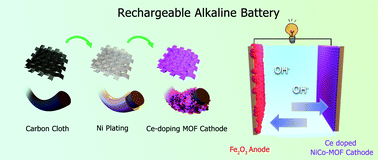Cerium-doped bimetal organic framework as a superhigh capacity cathode for rechargeable alkaline batteries†
Abstract
In this work, cerium (Ce)-doped NiCo-MOF (metal organic framework) was investigated for its application as a cathode material of alkaline batteries. Inert substitution of Ni/Co by Ce in MOF can make Ce to become part of the backbone of the framework and then ensure structure stability during redox reaction, which greatly improved charge and discharge cycle stability. With dopant mole fraction up to 5%, the redox potential of NiCo-MOF increased by 85%. Adequate Ce doping can potentially enhance rate capacity dramatically due to the large ion radius that provided an extra space for electrolyte ion shutting channel. 1% Ce-doped NiCo-MOF, having a capacity of 286 mA h g−1 at 2 A g−1 and retaining 93% of its capacity (265 mA h g−1) at 20 A g−1, emerged as the best performing material among all the Ce-doped NiCo-MOFs presented in this study. A full cell coupling Ce-doped NiCo-MOF cathode and Fe2O3 anode was assembled to verify its practical application. The full cell showed an initial capacity of 280 mA h g−1 at 2 A g−1 and retained 92% after 1000 charge and discharge cycles. Therefore, Ce doping emerges as a powerful strategy for the designing of cathode materials used in advanced alkaline battery.

- This article is part of the themed collection: 2021 Nanoscale HOT Article Collection


 Please wait while we load your content...
Please wait while we load your content...